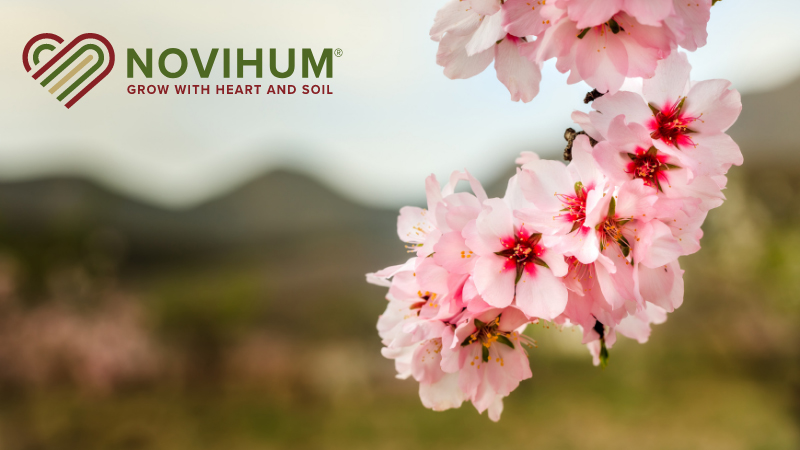Maximize Produce Profits By Focusing On Soil Health
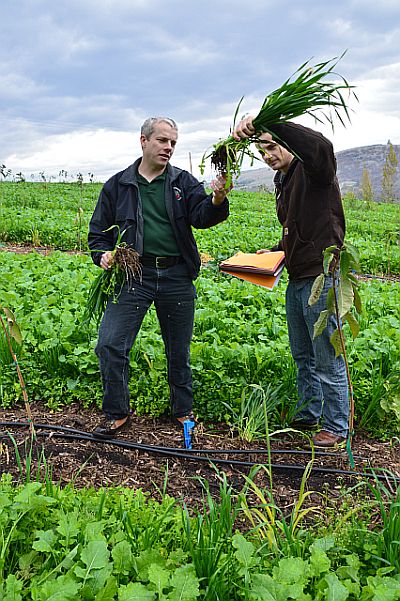
Cherry grower Mike Omeg says he noticed improved yield and quality within a year after adding mulching and composting as well as a diversity of cover crops to his orchard. (Photo credit: NRCS Oregon)
As a grower, what is your most important asset?
You might say a prized cultivar or a profitable crop. Others might say a new piece of equipment or a farmhouse or structure that’s been in your family for generations.
Believe it or not, your most prized possession on your property has a much deeper significance.
“I consider soil to be one of the most important factors in our success as farmers,” Mike Omeg, a fifth-generation cherry grower in The Dalles, OR, says.
The condition of your soil should be a top priority, and industry experts say you’re spending too much time focusing on what you see and not enough time on what you don’t see — ensuring your foundation is strong.
“We tend to forget that as farmers, once we get busy managing our orchard, how important the soil is,” Omeg says. “Oftentimes, we only think about soil in depth when we’re thinking of buying a piece of ground or leasing a piece of ground. We take it for granted and don’t maintain it as an asset.”
Take, Take, Take
The way we grow most fruit crops — long-term plantings of trees or vines — actually causes many of our common soil problems.
In order to understand what 20-plus years of one crop could do to your soil ecosystem, think of your soil like a bank account, says Bill Brush of B&B Ag Consulting in Modesto, CA. Your crop is making nutrient withdrawals year-in and year-out.
“Almost all of these crops are removal crops. You are removing the fruit, nut, all of its components,” Brush says. “Your soil supplied the ultimate pounds of nutrients to make that crop — all of those elements whether they’re in the fruit or not, are leaving the ranch.”
Naturally, with so many withdrawals from your soil bank account for 25-30 years, at some point there will be insufficient “funds” or nutrients.
Brush says it’s important to understand what types of nutrients are being depleted from your soil and to make sure you’re returning those to the soil, and, ultimately, the plant.
“Almonds are a high potassium removal crop. There is a lot of potassium in the nut, the hull, and in the shell. We know potassium becomes very important for almonds,” he says.
Looking Down, Not Up
It’s easy for growers to neglect the soil and root system of trees and vines.
“If you walk with a fruit tree grower in his orchard, where is he looking? He’s looking up at the trees. Why? That’s where the money is coming from,” Brush says.
But for Omeg, improving the canopy below the surface became a priority, a way to increase orchard income.
“We had become very good horticulturalists at managing the tops of our trees, from the ground up,” he says. “We weren’t paying attention to the canopy underneath. I saw the soil as sort of an untapped area of opportunity for me to make a big impact on the profitability of the farm. I decided that we were going to make soil as important a management factor as any of the other management activities that we do on the farm.”
What Makes For Good Soil?
Experts agree with Omeg about the importance of good soil in the orchard.
“Soil is more than a medium for holding plants up. It is the foundation of plant health. It provides the water, minerals, and nutrition necessary to give life to plants,” says Garrett Duyck of the Natural Resources Conservation Service in The Dalles, OR. “This is especially important for fruit trees, because they have more specific nutritional demands than most row crops to provide quality yields.”
Different types of soils influence the productivity of the nutrients you apply, as well as the absorption of water. Sandy soil has excellent water infiltration but does not store water well. Clay soil has poor water infiltration but good water retention. Silt is a good balance.
It is also important to know your soil pH. Nutrients are absorbed best at certain pH levels.
“Ideal pH for most crops, and tree fruits seem to fit this, is 6.5-7.0, just slightly acidic. This is the spot where the greatest number of soil nutrients are in forms available for plant root uptake. As pH goes down, certain elements become unavailable while others can be more available to the point of potential toxicity,” David Granatstein, sustainable agriculture specialist with Washington State University in Wenatchee, WA, says.
Low soil pH can also damage tree roots.
“Toxic effects can also result from manganese toxicity below pH 5.5, a disorder known as ‘bark measles’ known to afflict particular Red Delicious and Fuji cultivars,” Gerry Neilsen, a research scientist with Agriculture and Agri-Food Canada, says.
Soil pH also can influence the microbiology of the soil. The subsoil is a world of microorganisms and micronutrients. There are more than 7 billion organisms within a pinch of soil. These microbes mine the soil for nutrients and help mineralize them before being absorbed by the plant. This microbiology influences the structure of the soil, water infiltration, and root penetration.
“Any nutrient is always much more active and biologically available to the plant once it’s been through that organism,” Brush says.
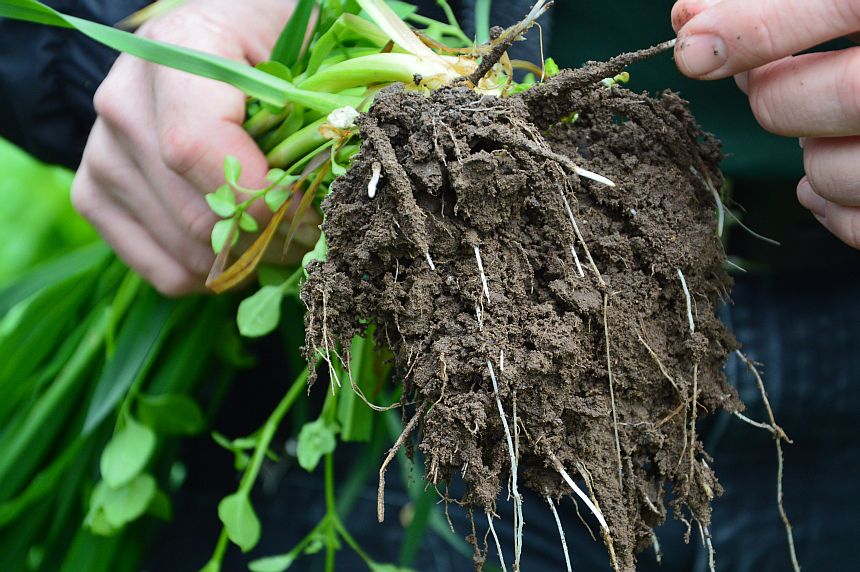
“Soil likes to have plant diversity growing within it. That’s how you get the most diverse soil ecosystem; you need a diverse canopy of plants growing above it,” Mike Omeg says. (Photo credit NRCS Oregon)
A Close Look At The Roots
Neilsen says it is also important to understand what type of roots your tree has. This will ensure that you are applying the proper fertilizer and nutrients where it is needed.
“Vigorous rootstocks often have widespread roots whereas a more restricted root zone can be expected in high density plantings on dwarfing rootstock. An extreme concentration of roots would occur on trees irrigated daily through drip emitters on coarse-textured soils,” he says.
Growers often measure nutrients after harvest, but there are other ways to monitor what’s going on under the surface. Leaf tissue testing throughout the season can help growers get a good idea of how successful their nutrition plan is. Soil sampling is valuable when it’s time to plant a new block of trees.
“There are nutrient interactions, so some people look at various nutrient ratios such as the relationship between calcium, potassium, and nitrogen in the fruit, and in the leaf, since this can influence fruit quality, especially things like bitter pit and storage life,” Granatstein says.
Duyck says there are four principles of good soil health: keep the soil covered, minimize disturbances in the soil, keep living roots growing, and increase plant diversity.
“Good soil health leads to good plant health. Good plant health leads to a plant that is able to withstand the environment, insect pressure, etc.,” Brush says.
Using Cover Crops To Improve Soil Health
Improving organic matter in the soil can have a direct impact on roots.
“It is arguably the single most important factor, as it influences physical, chemical, and biological properties of soil,” Granatstein says.
To improve his soil, Omeg sought to educate himself on soil basics. Cover crops were step one.
Omeg has been using cover crops as part of an orchard renewal program for new planting and also in the alleyways of his family’s tree rows instead of the common sod to increase the microbial diversity of his soil.
“Soil likes to have plant diversity growing within it,” he says. “That’s how you get the most diverse soil ecosystem; you need a diverse canopy of plants growing above it.”
Omeg added a few different types of cover crops as part of a “mow and blow” technique in his alley rows. Besides diversity, this helps add carbon to the soil in the form of mulching.
“Mow it with a mower that will blow the clippings onto the tree row. Chop up prunings after winter and sweep them onto the tree row with the brush rake with the belt reversed,” Granatstein says.
Using the alleyways in such a manner is sustainable, Omeg says.
“Now I can make every inch of my acre be contributing to the crop instead of just having it be an area where I could drive my equipment through,” he says.
Omeg says he is still working on determining the best cover crops for high-density tree fruit systems, which is actually the subject of a three-year USDA Sustainable Agriculture Research & Education (SARE) grant he received. So far he says he’s had success with annual ryegrass, daikon radish, and forage kale.
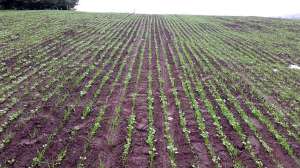
A before photo of a block in a renewal program. (Photo credit: Mike Omeg)
Bottom Line Results
“It stands to reason that you’ll make more money if you make your soil better. If you can improve your soil, that’s going to improve your economic return,” Omeg says. “If you question whether some of these activities improve your soil or not, give them a try because they actually don’t cost you much money.”
Omeg says trials are a part of everything he had his family implement in their orchard. In the summer, he has a fruit analysis lab in the orchard.
“We evaluate all these things and the impact they have on the crop, the fruit quality, the size, and the firmness, because that is going to determine whether it is a profitable endeavor or not,” he says.
But you don’t have to spend a lot of time on analysis. Implement a small trial where you focus on improving your soil in a block. As the season progresses, pick fruit from your trial and compare them side by side with fruit from the rest of the orchard. You’ll notice a difference, he says.
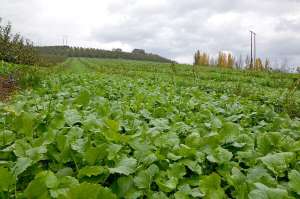
Young cherry trees are surrounded by a diversity of thriving cover crops in the alley rows. Omeg says this diversity helps to provide his trees vital nutrients and every inch of land is contributing to the trees. (Photo credit: NRCS Oregon)
Using mulch and compost with soil stimulant and nutritional sprays have made a huge impact on his orchard, Omeg says.
“I’ve been surprised with how fast we’ve seen the compost and mulch treatments that we were doing provide me with the return on my investment within the first year,” he says. “The conventional agriculture thinking is that the soil is something that is very hard to change. But we’ve seen big improvements and had a positive return on our investment within the first year of applying these mulches. That was what got me really excited about continuing this work. Because I thought ‘Wow, this is making money right away.’”







